

Closing a deal, especially in SaaS, can be hard.
In most industries, there is many of established competition as is, and you really have to put your value proposition right in front of your potential clients to get them to even consider you.
Then, you do close the deal and acquire customers💰
But the sales process being over doesn't mean you're even halfway done.
It is time for the client onboarding stage.
That's where you increase customer retention rates and make sure customer churn is out of the question.
TL;DR
- Client onboarding is a process of familiarizing clients with your product to trigger frequent use and in the long term, customer retention.
- The client onboarding process consists of 6 steps: welcome email, first-use in-app user onboarding, feature promotions, first week check-in, in-depth product use promotion, updates & check-ins.
- Client onboarding matters for 3 essential reasons: it helps you understand your users, retain them, and acquire more customers.
- Client onboarding best practices differ from product to product but some best practices for every product are:
- Knowing your product,
- Knowing your client base and their expectations,
- Considering past mistakes and wins during previous client onboarding processes,
- Coming up with a well-established client onboarding strategy,
- Communicating the purpose to your team(s),
- Using the right onboarding tools during the design and execution stages,
- Customizing and personalizing,
- Checking in with clients and asking for feedback whenever possible,
- Promoting frequent use with engaging material,
- Learning from your mistakes, optimizing & iterating
What is Client Onboarding?
Client Onboarding or customer onboarding refers to the process starting during or right after the sales process and consists of welcoming customers into your product, paying close attention to their worries and possible questions that may emerge during the process, and making sure that they make the most of this entire process and fully understand the value of the product or service you provide.
A customer onboarding strategy is a business strategy that every business needs.
Since it directly connects to your customer’s experience of your product/service and dictates your client relationships, a good customer onboarding process has the potential to increase overall customer satisfaction and decrease churn rates thanks to happy customers.
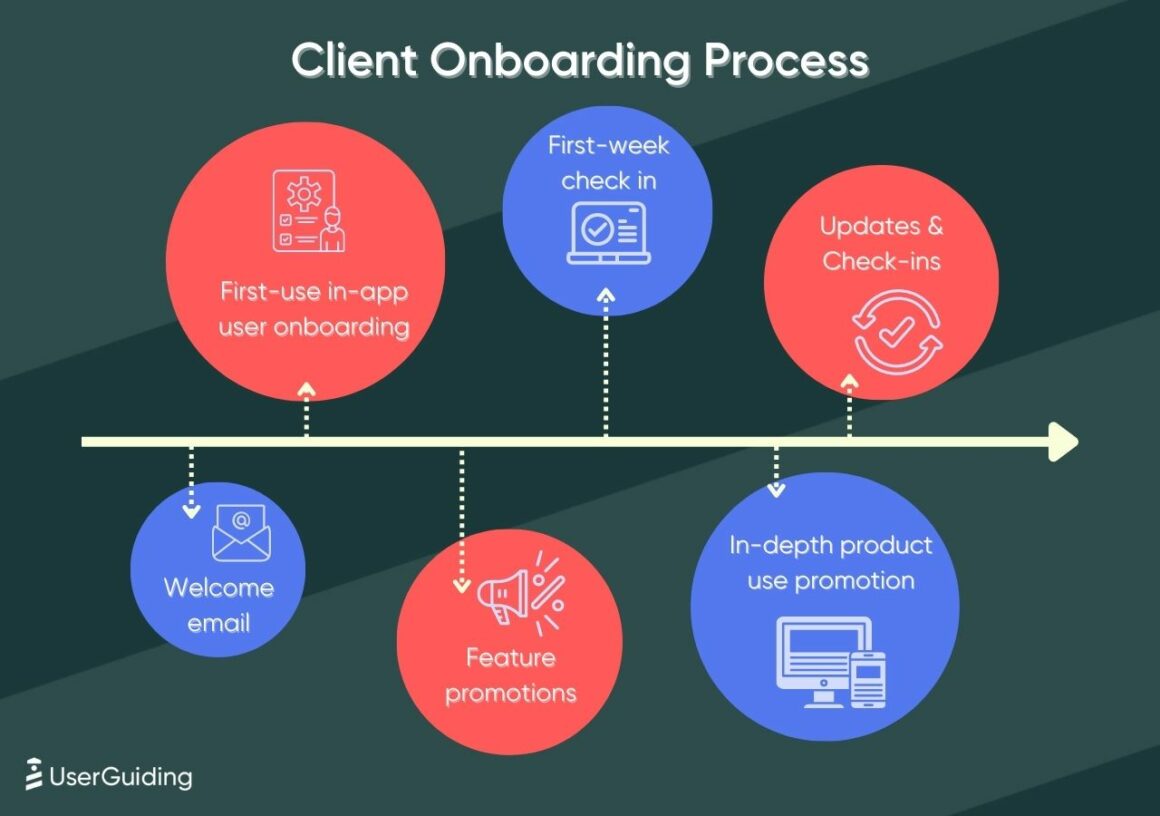
What Does the Client Onboarding Process Look Like?
The client onboarding process can easily change from product to product, but a general look at a possible line of actions can be:
1- Welcome email
Depending on your product, you might have already sent an email during a demo registration or a free trial.
But that doesn't mean you can't welcome users once again.
A well-written welcome email is short, engaging, and personalized. And in our case, it should be extra special to start building the perfect business relationship.
2- First-use in-app user onboarding
User onboarding is one of the most crucial steps of customer onboarding, and it can impact the client onboarding process entirely.
Positively - or negatively.
This is the onboarding stage to start out with educational content, client onboarding checklists, product tours, and app tutorials if you have any.
Here's how aclipp does it:
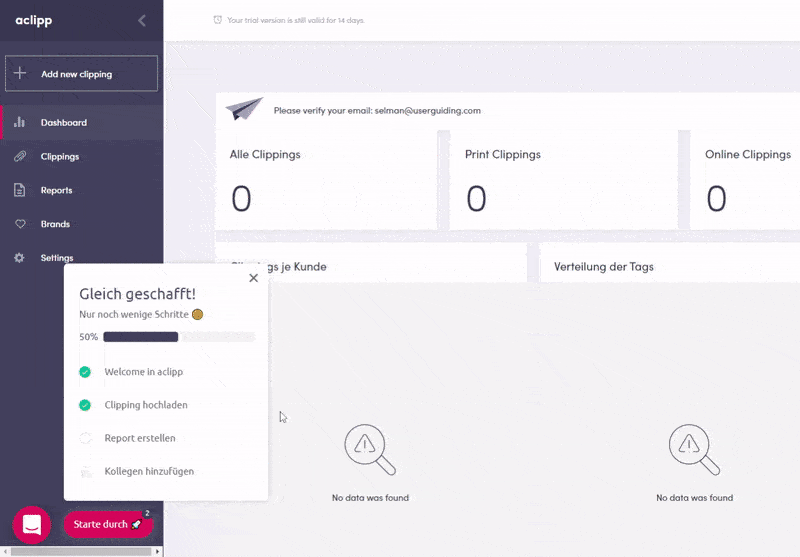
3- Feature promotions
You need to be offering value at all times.
So, the initial user onboarding process won't cut it in onboarding users fully and successfully.
Right after your clients have learned about the essentials of your product, they will need to constantly go through feature onboarding processes for new features and existing features they haven't discovered yet.
But be warned: not everyone likes promotions.
Make sure it is actually valuable to your specific customers at hand and keep it contextual.
4- First-week check-in
A week can change your client's feelings about your product entirely.
So, you have to frequently check on your clients to see if they are doing okay, still getting value, or have any unanswered questions.
NPS surveys, in-app communication, or other forms of feedback collection might come in handy.
Or you might want to schedule a check-up call if you want to turn your client experience into a personalized experience.
Whatever defines a successful onboarding flow for you 🤷
5- In-depth product use promotion
After the first week, the user journey will reach the point where you have confidence, and your client has the ability to learn more about your other features and functions.
Since you have more data on your clients, it is also easier to offer more value according to their specific needs that you had time to figure out.
Customer journey automatically enhanced 🚀
6- Updates & Check-ins
Onboarding is forever.
That is, as long as your product keeps growing and updating.
So, you'll need to not only update your clients every time there is something new going on, but you'll also need to check if they are still getting the worth of their money, if they are in the right plan, if they can be upgraded or downgraded, etc.
This stage can frequently take place unless the customer cancels.
Keeping up with these stages and especially with the very last one, is how you - and your clients - reach long-term success in your client onboarding experience.
But here's a more important question:
What exactly is it that makes a good client onboarding process so important?
Let's take a look at the "why?" of the client onboarding process:
Why is Client Onboarding important?
In the customer lifecycle, onboarding is a critical stage.
If not the most important, that is.
It plays a significant role in displaying the true value of your product and maintaining an ongoing relationship with your clients.
But beyond all that, there are 3 main reasons that make the client onboarding process essential:
1- Client onboarding helps you understand your clients better
Your clients are no enigmas.
Or at least they shouldn't be an enigma.
To find out what brought your clients to your product in the first place and what they want to achieve with the help of your service, client onboarding is a great tool.
When onboarding, try to look for answers to some unanswered questions like:
❓ What do they want to achieve with my product?
❓ What’s preventing them from achieving what they want?
❓ How can I help them get rid of pain points?
Answering these questions will then let you:
👉 Improve your product depending on your buyer personas and customer base,
👉 Have a more effective onboarding process for clients and users,
👉 Increase feature and product adoption,
And more.
Basically, a client onboarding process gives you the opportunity to get in closer contact with your clients and find out how to create a more seamless experience.
Which then improves your customer onboarding process even more.
2- Client onboarding helps you retain more clients
Two words for you that instantly cause a terrible headache: Client churn.
I assume the last thing you’d want is for your clients to give up on you and move on with some other service at the first chance they get.
How do you prevent that?
By putting effort into increasing your client satisfaction and client retention.
And what will get you there?
You guessed it. A good client onboarding process.
A well-designed, well-executed client onboarding process can:
👉 Give your clients the message that you really care about them,
👉 See further value in your product,
👉 Streamline business processes with automation,
👉 Create positive experiences that will affect the overall client experience
And do a lot more, like:
3- Client onboarding helps you gain more clients
What if you leveraged your customer retention efforts to acquire customers?
More specifically, what if you used your client onboarding process to get onboarded clients to do your marketing?
You guessed it; I'm talking about word-of-mouth marketing 👄💬
And I'm not even proposing that you add product promotions to your onboarding process.
An effective onboarding flow designed with the intention of displaying every piece of value you offer can easily get users to talk.
And talk. And talk more.
As long as you know the talk is not negative, you have a good funnel of client acquisition thanks to client onboarding.
Another great thing about a good onboarding is that it’s repeatable.
Once you create a good piece of client onboarding, it is easily usable in different onboarding flows and processes.
This loop will enable you to grow your business in an efficient, easy, and speedy way.
Now that we know the meaning, the detailed steps, and the importance of client onboarding, let's talk about how to onboard clients with some best practices
How to Onboard Clients in 10 Steps (Best Practices)

1- Know your product
It all starts with knowing the material you're working with.
To create the ultimate client onboarding process, you have to know what you are onboarding people to.
You can't onboard Grammarly users to the platform with in-app product tours only, no one really uses Grammarly in-app anymore.
Similarly, a full-on email client onboarding process for Slack could be ironic as the whole deal of the product is to decrease dependency on email sequences.
So naturally, knowing how to onboard clients starts with knowing your product.
Ask yourself these questions:
❓ What is my product's nature? Where is it available? Is it mobile? Does it require frequent use?
❓ What's my brand voice?
❓ What unique features do I bring to the industry? What's unique about my value proposition?
❓ How is my overall client experience without the client onboarding process?
But there is one other thing that you need to know very well:
2- Know your clients & their needs
Knowing your product is only one face of the coin.
Without knowing your clients and exactly what they need for a flawless customer experience, you can find yourself playing a losing game.
Some questions you need to know the answers of are:
❓ What is your client persona? Who are you trying to onboard?
❓ What main feature/function/value is your client persona interested in? What brought them to you?
❓ Do your clients need training courses/educational content/product walkthroughs to get onboarded? Can you minimize the onboarding process for higher customer satisfaction?
And others depending on your product and client onboarding workflow.
The point is to figure out what makes your clients happy by looking into the details of your client base.
3- Consider past onboarding experiences
This is an important best practice unless you are a brand-new business with no experience in onboarding clients.
The very best client onboarding processes shape up after figuring out what went right and what went wrong during prior client onboarding experiences you had with loyal customers and early-churners.
Some mini best practices you can try out:
👉 Collecting client data from old onboarding processes that failed and succeeded (industry, pricing plan, features onboarded, and features most interacted with)
👉 Finding 3 mistakes and 3 wins in each onboarding and sign-up process
👉 If you have used different onboarding methods, comparing them (kick-off call, email sequences, video tutorials, etc.)
👉 A detailed look into how the handoff from the sales team used to take place
👉 Preparing action items to improve for your new client onboarding process
Once you have gone through all these, you can move and:
4- Come up with a client onboarding strategy
Once you know what your product is, what your clients need, and how you used to do client onboarding, you have all the data to create the ultimate client onboarding strategy.
Except for one last element: desired outcomes.
Your client onboarding strategy must consider the material at hand, the past, and the expected future.

Now, even though coming up with a client onboarding strategy essentially is a complex, extended business process, it must still be explainable using a few words, similar to a value proposition.
Remember: it's not a slogan, it's not a catchphrase, but it is simple enough to understand.
This is essential so that you can easily:
5-Communicate purpose to your team
As much as it is important to work swiftly with a smaller group of people, a client onboarding process must be clear to an entire company.
Especially if you value streamlined processes, you might want to make sure that:
👉 Everyone in your customer success, customer service, sales, and marketing team can summarize your client onboarding process in a few sentences,
👉 The rest of the company has an idea of how you onboarding clients,
👉 Stakeholders are encouraged to present ideas that can optimize the client onboarding experience,
👉 Client onboarding is considered when making important decisions
If you can ensure these 4 criteria are met, you have greater chances at a successful client onboarding AND a streamlined workflow in and between all your teams.
6- Design with the right tools
Now that we got the ideation part down let's talk about some practical best practices.
And let me make this clear:
Onboarding clients is unnecessarily cumbersome if you're not using the right tools.
Or worse, no tool at all.
The thing is, even if you prefer a manual onboarding process, you'll need certain tools to make sure you offer a successful onboarding flow.
You might need to use HubSpot to check your contacts, Mailchimp to do email onboarding, Zoom to do kick-off meetings, or other tools that can work as parts of a client onboarding platform.
And even with all those tools, you still might need to spend time and money on coding your in-app client onboarding.
Why not give an automated solution a try?
UserGuiding: Onboard Clients the Right Way ✨
I once spent 3 hours trying to teach my mom how to use her new laptop.
I was holding the laptop; she was watching me.
She asked questions, said she "got it" several times, and still called me the next day asking how to do something I could swear I taught her.
After she called me for the fourth time that day, I told her to figure it out on her own.
You know what she did? She did figure it out.
Apparently, all those times she asked me how to do something, she didn't even try doing it 😬
After getting her hands on the thing, she did delete a thing or two accidentally, but she was doing good.
Now, you might be asking, why did I tell you the story of my technically illiterate mom?
Because it is pretty similar to client onboarding in the tech field.
You might think you are doing a good job personalizing the process, but if you can't do it perfectly, your clients are going to roll right back.
And they are going to think that it's either you who failed to teach them or that your product is trash 🗑️
So, why not automate and get it hands-on?
Meet Userguiding.
UserGuiding is a no-code client onboarding platform that can help you create:
✅ Interactive walkthroughs, guides, product tours,
✅ Customer onboarding checklists,
✅ Hotspots, tooltips, in-app messages,
✅ Knowledge base widgets called resource centers,
✅ NPS surveys,
And more.
All powered with in-depth analytics, high customization, user segmentation and targeting.
Interested?
👉 Try UserGuiding for FREE 👈
7- Customize & personalize
Now, as much as I like to promote automated onboarding, one thing to keep in mind is that:
Personalization is irreplaceable.
If you are automating the process, there is no way you can make your clients feel like they are talking with a robot too.
For example, Notion does a good job keeping their in-app messages personal:
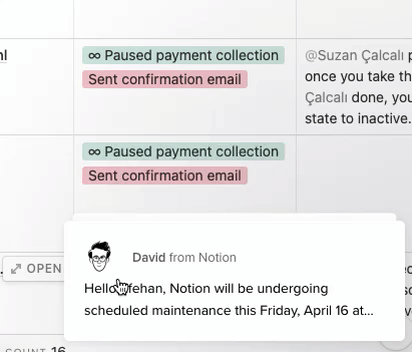
And this outreach from G2 gets my attention just by using my name:
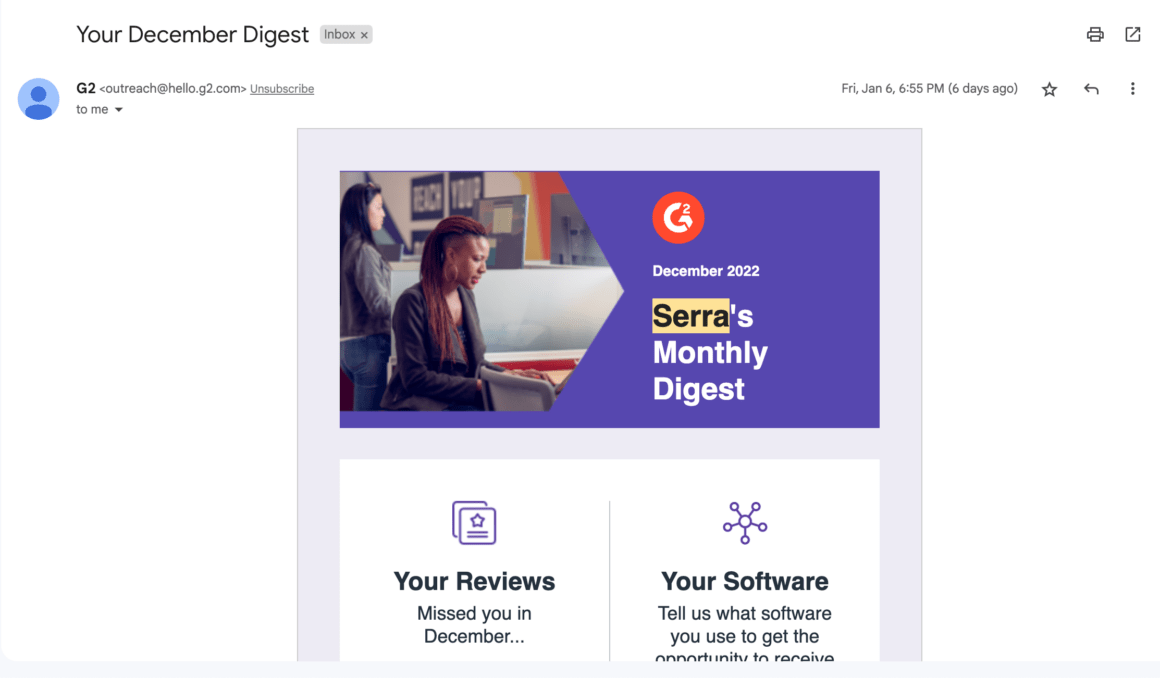
It is almost exactly the same case with customization.
Showing off your brand style, voice, and image can and will always win you extra points in the eyes of your clients AND it will be a lot easier to get their attention with unique client onboarding elements.
So, I say, start personalizing and customizing your process right away.
8- Check in & ask for feedback whenever possible
Who here answers all customer surveys they come across?
No one?
Who appreciates - consciously or subconsciously - being asked because it shows your opinion matters?
I just know there's at least a good 50% here.
Well, never pull up an entire client onboarding questionnaire.
But if you do it right, keeping the survey short and nice with easy questions, there is a lot to be learned from client feedback from surveys they will actually answer.
Here's how Around asks me super nicely to take a survey:

Take it from me; even if they won't take the survey, they will at least appreciate you and know that the tool is being improved.
That's one impression I'd personally love to leave 😎
9- Promote for more frequent use
In the long run, client onboarding eventually turns into new feature onboarding.
And in promoting your new features, your essential aim is to get your users to adopt the feature and use the product more often.
Being aware of this and making sure your promotions and user engagement efforts align with this goal is essential.
For example, Duolingo's follow-up email does it in such a subtle and convincing way:
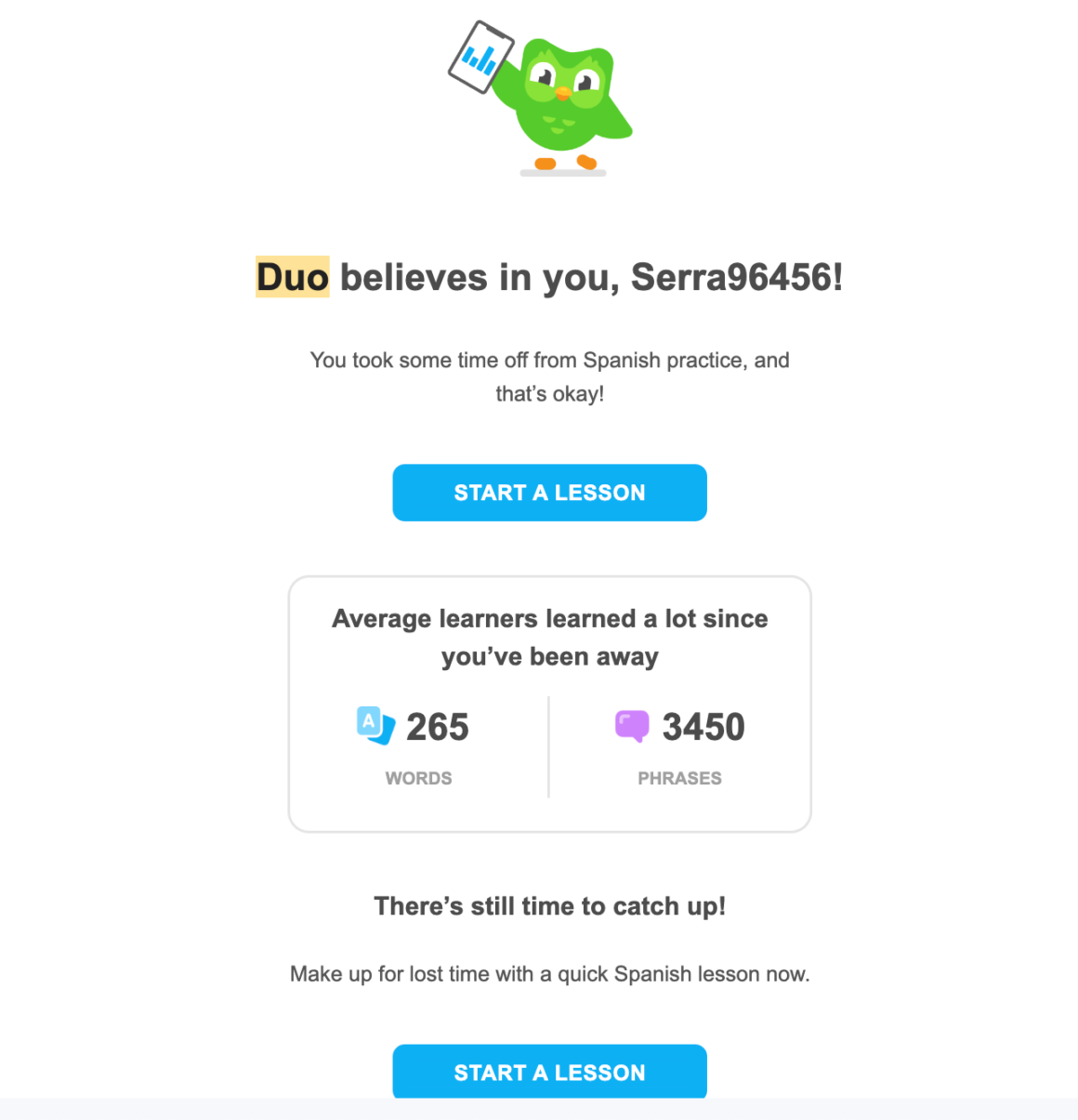
Even when you don't have a new feature or update to promote, you can use your own product data and good copy to get clients back in.
10 - Learn from your mistakes, optimize & iterate
Probably the most important best practice of client onboarding in the list is our very last one:
Learn from your mistakes, optimize and iterate.
The definition of success for a client onboarding process might be very different for each product, but if you fail, it only means you have more to learn from and optimize.
The trick is to keep improving and repeating.
Your clients won't onboard themselves. (Or are they?)
To Wrap Up
A client onboarding process is not as easy as getting a client's email address and sending them user manuals, nor is there a one-fits-all customer onboarding template.
A kick-off meeting alone won't guarantee client retention and onboarding tools need to be used wisely.
But in the middle of all that, there are actionable ways and best practices to make your client onboarding process effective.
Hope I managed to cover some good ones 😊
Good luck in advance, and remember, a successful onboarding process is not for preventing churn, it is for increasing retention.
It would be paddling against a current otherwise.
Frequently Asked Questions
What is the first step in the client onboarding workflow?
The first step in the client onboarding workflow is the initial conversation. This first conversation you have with your clients will significantly impact your decision-making process to address their problems and create services that speak to their needs precisely.
What should be included in client onboarding?
In the client onboarding process, important steps such as communication, understanding of the needs, role reviews, further discussions, and follow-ups of any kind should be included.

















.svg)
.svg)
.svg)
.svg)
.svg)

.svg)
.svg)












.svg)
.svg)




.png)
















